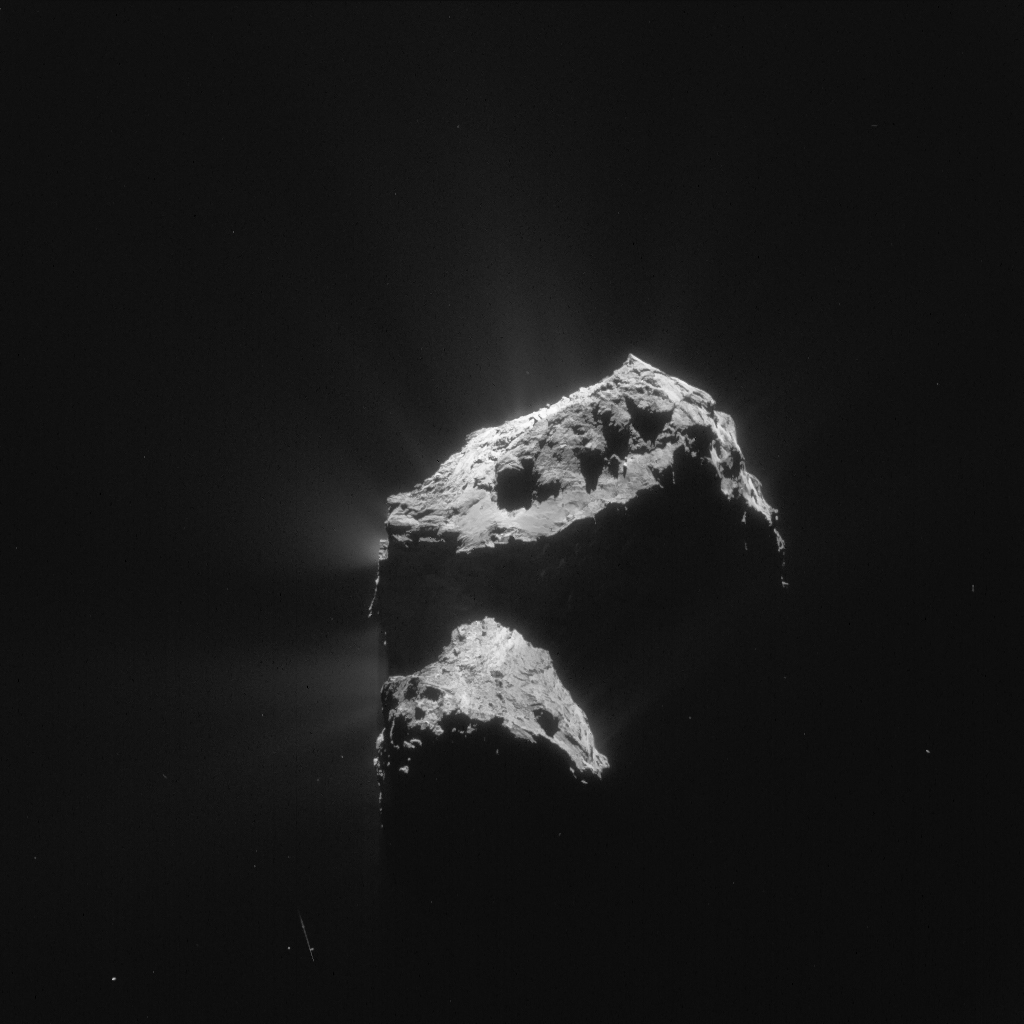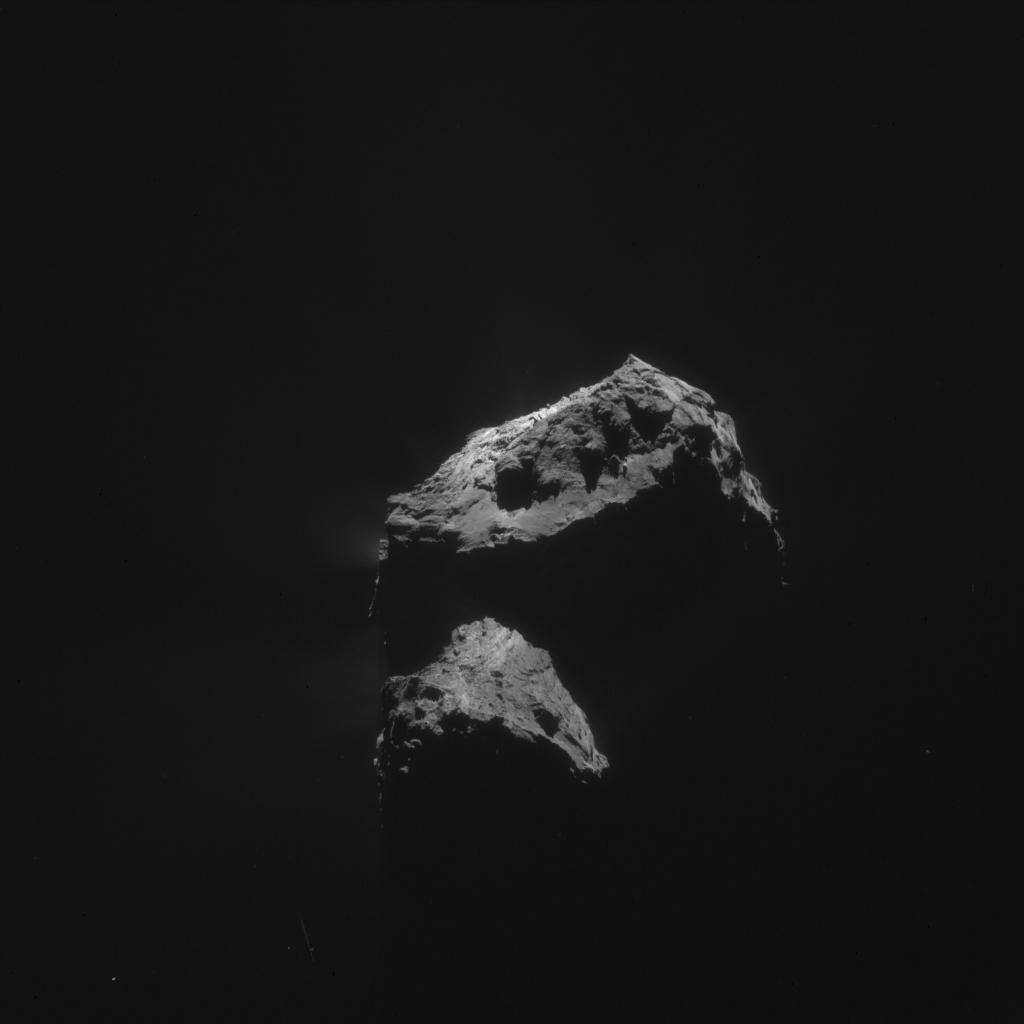Today’s CometWatch entry is a NAVCAM image taken on 7 December 2015, when Rosetta was 103.1 km from the comet nucleus.

Single frame enhanced NAVCAM image of Comet 67P/C-G taken on 7 December 2015. Credits: ESA/Rosetta/NAVCAM – CC BY-SA IGO 3.0
The scale is 8.8 m/pixel and the image measures 9 km across. The contrast was increased to reveal the beautiful details of the comet’s activity, especially on the upper and left sides of the nucleus.
With the large lobe up and the small lobe down, this image shows an interesting view of the comet and a stunning juxtaposition of lit and shadowed areas on the surface of 67P/C-G.
On the large lobe, the image offers a great view on the smooth terrains of Anubis and, further away, on the more irregular region of Atum. Towards the right, hints of Ash are also visible.
In this curious orientation, the two lobes appear as if they were separated, with the regions between them – Seth, on the right, Hapi at the centre and Sobek towards the left – cast in shadow. On the small lobe, the view is dominated by the complex terrains of Anuket.
The original 1024 x 1024 image of today’s CometWatch is provided below:










Discussion: 18 comments
‘Onion’ analogy so un-evident at this one…
Logan
The onion rings are the three large ridges on the right, casting shadows. And probably the fourth one to the left too. These are the exposed ends of the onion strata, nested over each other.
‘Core’ material indeed seems to be core. Cometary, dominantly crystalline kind.
This is fiction.
At this post-perihelion phase hard layer remains stand on, ‘erected’ as menacing monoliths.
Pixel 383,540 of the full 1024px of:
https://www.esa.int/spaceinimages/Images/2015/12/Comet_on_7_December_2015_NavCam
Remembering of those ones of the neck ‘singularity’.
A similar orientation was seen in the B image on 26 October. Am struck by how many near-right angles one can see on the boundary. How do the gravity vectors here look like?
Kamal
The body is an almost perfectly symmetrical diamond shape. This partly answers the right angles question. The other part of the answer (in my view) is that slabs were shed during spin up and they sheared along tensile force vectors which are likely to be very straight unless diverted around a particularly solid lump of core. In the case of Anubis the slab sheared away to the right in this photo and the onion layers were torn away in the process hence their ragged ends.
🙂 From always expecting ‘unbounded’ crystallization.
But when seeing this:
https://blogs.esa.int/rosetta/2015/04/17/cometwatch-15-april/
Warping. If perspectives like this prove to be non ‘unique’, Then scientists will have to move cometary genealogy farther from the Proto Solar disk, towards the Full environment of the Stellar Group/Cluster.
By the way, another parabolic segment at down right of this shot 🙂
With axis going all the way from Imhotep to Hatmehit 😉
Dominant layering going from pixel 635,558 to 522,510 of
https://blogs.esa.int/rosetta/files/2015/04/ESA_Rosetta_NavCam_20150415.jpg
That’s a nice view of the three stepped-down strata on the right of the head lobe in this photo. They’re right on the head rim and there’s a corresponding step-down of three strata directly below them on the body. These were matched on the stretch blog (Part 17) in March 2015 from the side, i.e. an angle 90° below this view. They were then matched from the south, a viewpoint to the right of this view in a comment on the first NAVCAM south pole picture on the Rosetta blog. They’ve now been matched from three orthogonally distinct views and still hold up.
When you turn the corner to the south pole side, the matches here on the very corner meet up with the south pole head rim and shear lines. Those two lines were matched on the first OSIRIS photo of the south pole. That photo was in the recent OSIRIS archive blog post. The head rim and shear line were traced in two continuous lines across the south pole from Maftet to Bastet on the head and from Anubis to Aker on the body. This means the head rim and body shear line have been matched around the entire perimeter of the comet.
Sorry, my right/left and up/down need reversing because I had swivelled the photo 180°.
But “there is no such thing as ‘living’ fossils”.
https://nautil.us/issue/22/slow/the-rise-and-fall-of-the-living-fossil
[Ferris Jabr, Science diffusion Writer]
As part of the blogs doubts, yet another scenario could be that 02 remains ‘actively’ hidden.
Escaping, chased, attached, trapped, then released. At an interminable dance of attachment/detachment.
Transiently appearing as a gaseous actor, when visiting warm sectors. Just to be ‘eaten’ back by the sempiternal night later.
…The sempiternal night of the ‘radiation free’ Universe.
The insides of Ducky are part of the ‘radiation free’ Universe.
Could all of us just be wandering? Could Ducky just be a ‘contemporaneous’, evolved planet-oid? The Object ‘who came in from the cold’?
logan re – comtemperaneous evolved planoid?
Certainly looks like it –
No wonder so long to get these fabulous pictures.
regards
Why doesn’t the photographs taken by Rosetta show 67/P tail when contrast is increased
George
You cant ‘see the tail’ because Rosetta is deep inside it.
The tail is an enormous structure which spreads over a huge distance compared to Rosettas distance to the comet.
The dust etc which you can see forms the tail.
So when inside a cloud, you cant really see the cloud you are in 🙂